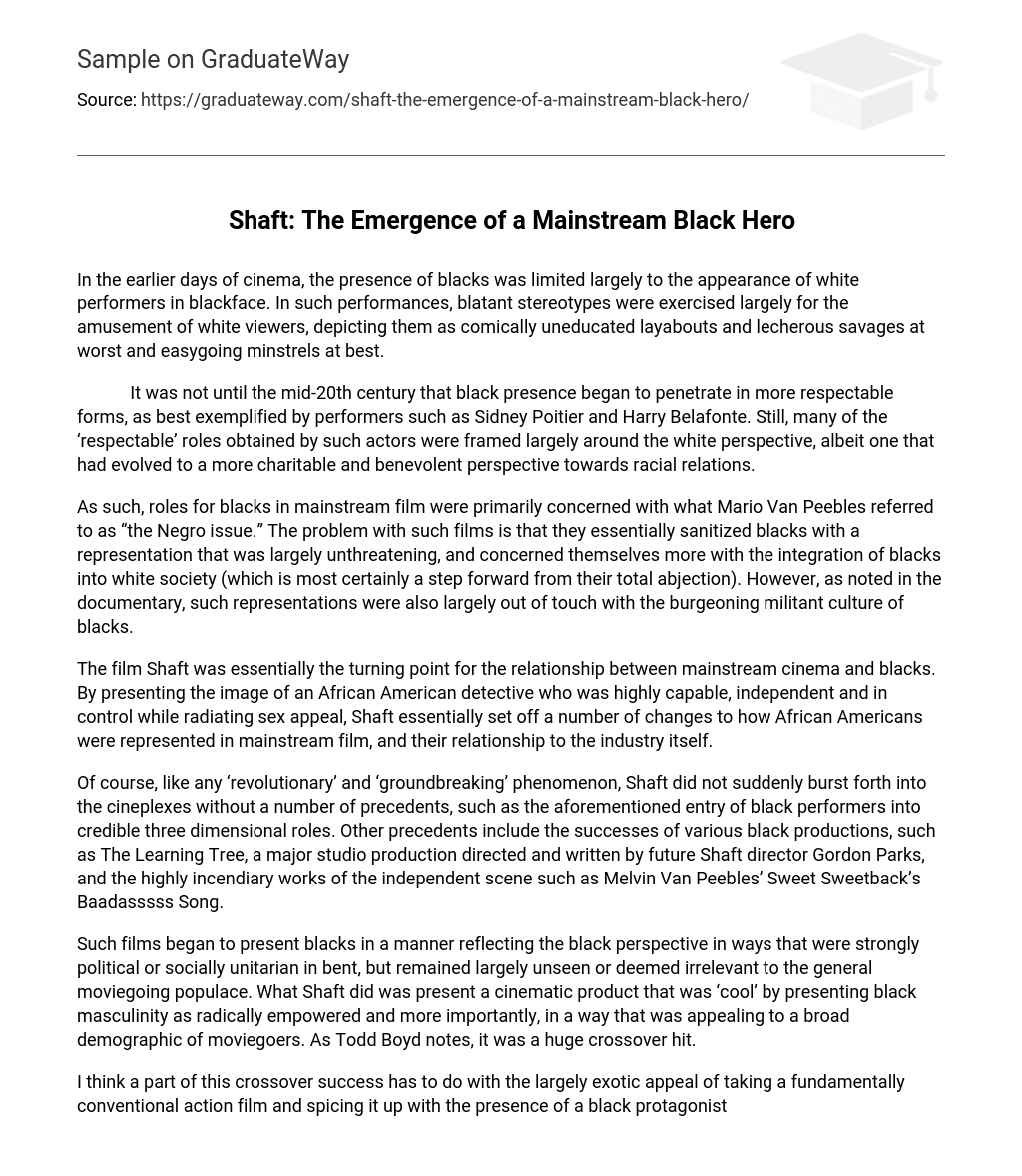In the earlier days of cinema, the presence of blacks was limited largely to the appearance of white performers in blackface. In such performances, blatant stereotypes were exercised largely for the amusement of white viewers, depicting them as comically uneducated layabouts and lecherous savages at worst and easygoing minstrels at best.
It was not until the mid-20th century that black presence began to penetrate in more respectable forms, as best exemplified by performers such as Sidney Poitier and Harry Belafonte. Still, many of the ‘respectable’ roles obtained by such actors were framed largely around the white perspective, albeit one that had evolved to a more charitable and benevolent perspective towards racial relations.
As such, roles for blacks in mainstream film were primarily concerned with what Mario Van Peebles referred to as “the Negro issue.” The problem with such films is that they essentially sanitized blacks with a representation that was largely unthreatening, and concerned themselves more with the integration of blacks into white society (which is most certainly a step forward from their total abjection). However, as noted in the documentary, such representations were also largely out of touch with the burgeoning militant culture of blacks.
The film Shaft was essentially the turning point for the relationship between mainstream cinema and blacks. By presenting the image of an African American detective who was highly capable, independent and in control while radiating sex appeal, Shaft essentially set off a number of changes to how African Americans were represented in mainstream film, and their relationship to the industry itself.
Of course, like any ‘revolutionary’ and ‘groundbreaking’ phenomenon, Shaft did not suddenly burst forth into the cineplexes without a number of precedents, such as the aforementioned entry of black performers into credible three dimensional roles. Other precedents include the successes of various black productions, such as The Learning Tree, a major studio production directed and written by future Shaft director Gordon Parks, and the highly incendiary works of the independent scene such as Melvin Van Peebles’ Sweet Sweetback’s Baadasssss Song.
Such films began to present blacks in a manner reflecting the black perspective in ways that were strongly political or socially unitarian in bent, but remained largely unseen or deemed irrelevant to the general moviegoing populace. What Shaft did was present a cinematic product that was ‘cool’ by presenting black masculinity as radically empowered and more importantly, in a way that was appealing to a broad demographic of moviegoers. As Todd Boyd notes, it was a huge crossover hit.
I think a part of this crossover success has to do with the largely exotic appeal of taking a fundamentally conventional action film and spicing it up with the presence of a black protagonist. Shaft made an action film interesting by re-coloring (pun intended) a role that would traditionally be filled in by a white performer, and at the same time it also made a black character interesting by presenting him as a credible action hero. This latter point has been certainly latched onto by many observers of the phenomenon that is Shaft. Todd Boyd remarks that Shaft “exemplified what it meant to be ‘cool’, and being cool was so important to black masculinity.”
One of the more direct effects of Shaft’s box office success is the resultant wave of “blaxploitation” that it incited. Suddenly, a large number of films were being produced to capitalize on African American cool. Shaft made African American flavored productions look like promising investments, not just in terms of embracing a new production aesthetic, but in embracing a heretofore ignored black demographic. From then on, over 200 audaciously edgy yet mostly formulaic films featuring the blaxploitation schtick were released, such as Superfly, The Black Six, Foxy Brown, Slaughter, and Cleopatra Jones. Even animator Ralph Bakshi jumped in to produce a controversial blaxploitation cartoon called Coonskin.
But more significantly, it replaced preceding sets of stereotypes of blacks with another stereotype that was at least empowering and positive for blacks who had become accustomed to demeaning roles in film. Some critics of the phenomenon charge these stereotypes as offensive, essentially replacing one negative stereotype, that of the “weak sexless Negro” with another one, “the super-sexualized violent predator.” These same critics gave rise to the very term “blaxploitation,” asserting that they were essentially cartoony. As such, the very wave that Shaft had set into motion began to devolve into self-parody and caricaturization.
Richard Roundtree, the former fashion model who portrayed the eponymous Shaft, and Spike Lee, a noted director of black social realist cinema, defend the resultant wave of blaxploitation as essentially opening the opportunities of employment for blacks in cinema essentially opening the door for more meaningful work in the decades to follow. “This was an entry into film, getting the experience in front of and behind a camera,” says Lee.
The primary significance of Shaft then, is that it had given blacks a space within the mainstream consciousness, not just in terms of the roles they can occupy within the fictional worlds of cinema but in the opportunities that had previously been closed off to them. By virtue of being a hero with mainstream appeal, John Shaft had made black culture mainstream. The effects of this ripple into today, beginning with the broadening influence of black fashion and music on urban culture and onwards into the increased acceptance of black lifestyle and sexuality as a pop image.





